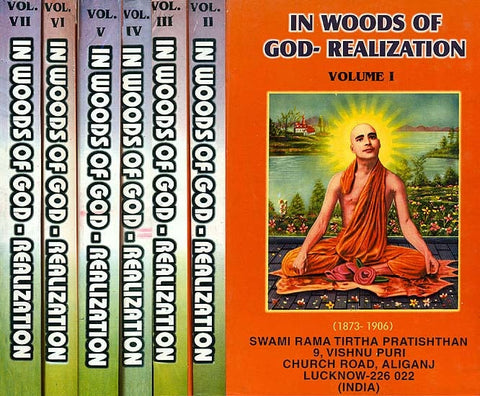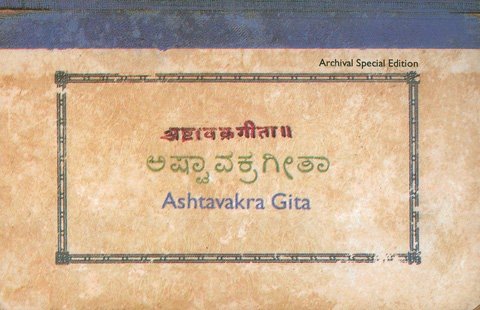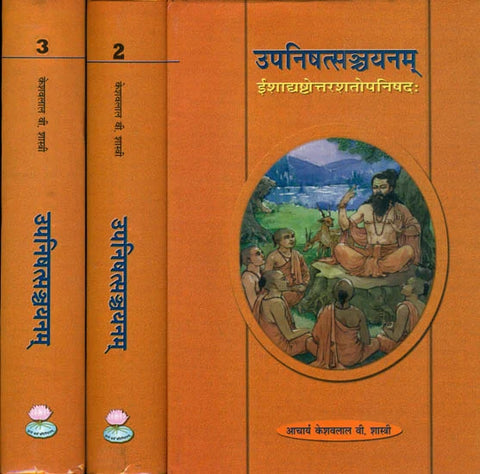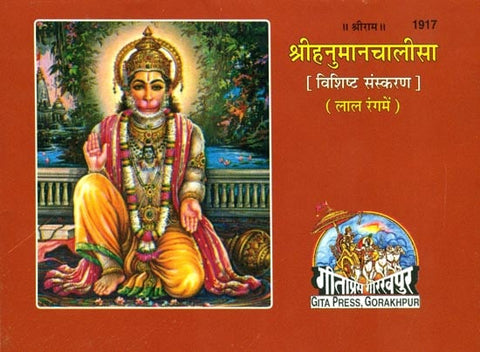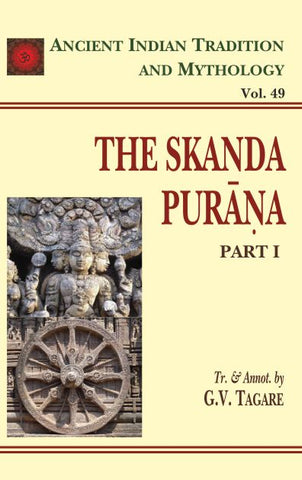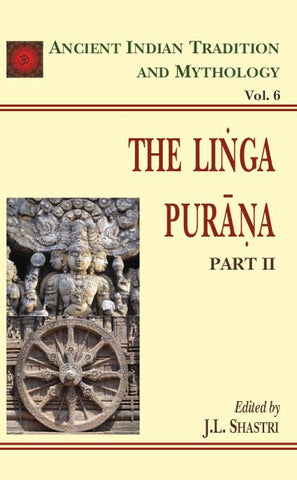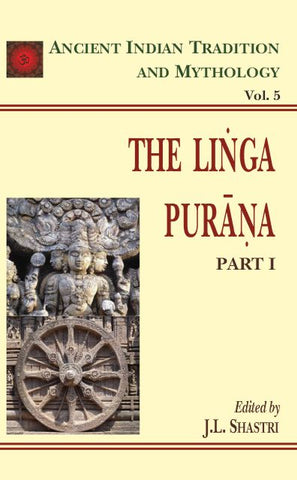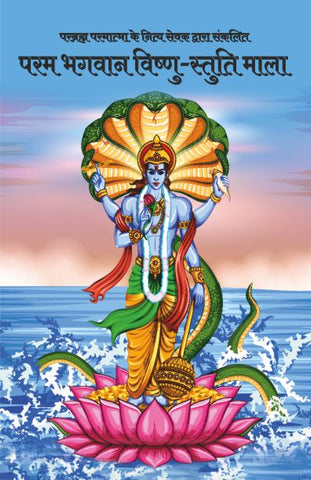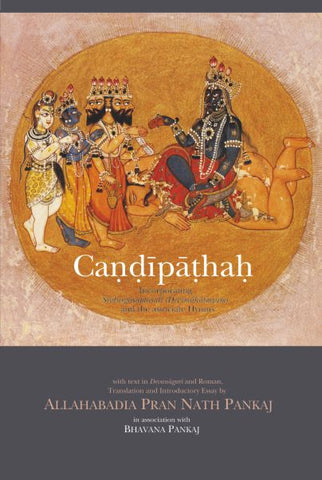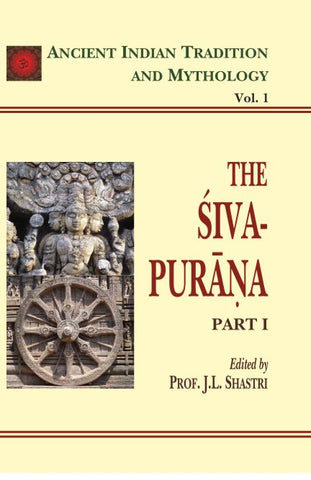Your cart is empty now.
The hymns to the Devi in this volume (introduced by a stotra to Her Spouse, the Kalabhairava) are taken from the Tantra, Purana, Mahabharata, and Sankaracarya, who was "the incarnation of devotion" (bhaktavatara) as well as a great philosopher; a fact which is sometimes ignored by those who do not wish to be reminded that he, whose speculative genius they extol, was also the protagonist of the so-called "idolatrous Hinduism." As his great example amongst many others of differing race and creed tell us, it is not, from the view of religion, the mark of discernment (even though it be the mode) to neglect or disparage the ritual practice that all orthodoxies have prescribed for their adherents.
Of the Hymns now published, those from the Mahabharata and Candi have already been translated; Adyakalisvarupastotra has also been previously published as part of a rendering of the Mahanirvana Tantra. It is necessary to study the Hindu commentators and to seek the oral aid of those who possess the traditional interpretation of the Sastra. Without this and an understanding of what Hindu worship is and means, absurd mistakes are likely to be made. The author has therefore availed himself of the Commentaries of Nilakantha on the Mahabharata, of Gopala Chakravarti and Nagogi Bhatta on Candi, and of Nilakantha on the Devibhagavata.
THE Goddess or Devi (as the Hindus call Her) is God (as the Western worshippers address Him) in Its Mother aspect. The latter not uncommonly deem such attribution of feminine quality to be " heathenish"; but this condemnation (for the criticism has, of course, this intendment) is itself singularly foolish in that it is thereby implied that of two sets of terms (neither of which is in its strict sense applicable to the Deity as the Author of forms), one is, in fact, a more correct description than the other. In the Navaratnesvara it is said: "That Devi, who is existence, consciousness, and bliss, should be thought of as a female or as a male, or as pure Brahman. In reality, however, She is neither male nor neuter (that is to say, that She is not bound to any particular form)." No one contends that the Brahma- tattva in the supreme abode beyond appearances is masculine as opposed to feminine, or the latter as contrasted with the former. Like all else in this matter, words are but the babbling endeavour of our plane to express that which is above it. It is not easy, then, to explain the condemnation except upon the assumption that those who pronounce it think their mother's sex to be inferior to their own and that thus Deity is un- worthily described by any other terms than those of masculine excellence. But Hindus, whoever places the name of the mother before that of the father, and to whom garbha dharanaposabhyam pitur mata gariyasi, have no partiality for such mistaken notions. On the other hand, it is possible that they might not understand the Christian expression" Mother of God," nor approve it even after they had learnt the limited and special sense that theology gives to this epithet. The Tantrika would least of all admit the insufficiency of the conception of God as Mother. For the Devi manifests in his own mother, in his prakrti (as he calls his wife), and in all women. As the Kubjika Tantra says: "Whosoever has seen the feet of woman let him worship them as those of his guru" (Strinam padatalam dristvaguruvad- bhavayet sada). Whilst male and female are both Her aspects, yet Sakti is, in a sense, said to be more revealed in the female than in the male form. And so the Mundamala Tantra says: "Wherever there is a sakti (female), there I am." On account of this greater manifestation, women are called Sakti. From this, however, it must not be supposed that Sakti is less present in such forms as Siva and Krsna and others. If, as the author of the Tantra Tattva says, a sadhaka who is a worshipper of the Krsnamurti desires to see Him as Kali, Bhagavan, who fulfils the desires of devotees, will assume that form. All forms come into existence upon the manifestation of consciousness In the play of Her whose substance is consciousness.
Though the Saktanandatarangint says: Devt is worshipped on account of Her soft heart (komalantah- karanam), the use of the term " Mother" has other grounds than those which are founded upon an appeal to the natural feelings which the sweetness of the word " Mother" evokes. The meaning of the term "Devi" is prakasatmika, or that which is by its nature Light and Manifestation. And the word is used in the feminine gender because the One, as Sakti and Prakrti, bears and nourishes all things as their Mother. The Devi is therefore the Brahman revealed in Its Mother aspect (Srimata) as Creatrix and Nourisher of the worlds.
Worshippers of Devi or Sakti are called Saktas. But those who have a true knowledge of Sakti-tattva without which, according to Sastra, Nirvanamoksa is unattainable, will in thought surpass the sectarianism which the terms " Sakta ", " Vaisnava "and "Saiva" ordinarily connote. Whatever forms the Devi assumes in Her aspect with attributes are but Her forms. As the author last cited says, the sadhaka will know Her, whether the appearance is that of Krsna, Durga, or Mahadeva. The Vaisnava may consider Her as Visnu in the form of Sakti, or the Sakta may look upon Her as Sakti in the form of Visnu. To those who, immersed in the ocean of Her substance, which is citsakti, are forgetful of all differences which appertain to the world of form, Krsnasakti, Sivasakti, or Kalisakti, and all other manifestations of sakti, are one and the same. And so Ramaprasada, the Bengali poet and Tantrik, sang: "Thou assumeth five principal forms according to the differences of worship. But, O Mother! How can you escape the hands of him who has dissolved the five and made them into one? "
The hymns to the Devi in this volume (introduced by a stotra to Her Spouse the Kalabhairava) are taken from the Tantra, Purana, Mahabharata, and Sankara- carya, who was "the incarnation of devotion" (bhaktavatara) as well as a great philosopher; a fact which is sometimes ignored by those who do not wish to be reminded that he, whose speculative genius they extol, was also the protagonist of the so-called "idolatrous Hinduism." As his great example amongst many others of differing race and creed tell us, it is not, from the view of religion, the mark of discernment (even though it be the mode) to neglect or disparage the ritual practice which all orthodoxies have prescribed for their adherents. Stava and puja are doubtless the sadhana appropriate to the first of the several stages of an ascent which gradually leads away from them; but they are in general as necessary as the higher ones, which more immediately precede the attainment of brahmabhava and siddhi.
Apart, however, from this aspect of the matter, and to look at it from the point of view of that modern product, the mere "student of religions," who is not infrequently a believer in none, a knowledge of ritual (to use that term in its widest sense) will help to a greater and more realistic understanding of the mahavakya of the Aryas than can be gained from those merely theoretical expositions of them which are now more popular. Those, again, whose interests are in what Verlaine called" mere literature" will at least appreciate the mingled tenderness and splendour of these Hymns, even in a translation which cannot reproduce the majesty of the Sanskrit slokas of the Tantra and Purana, or the rhyme and sweet lilting rhythms of Sankara,
Of the Hymns now published, those from the Mahabharata and Caridi have already been translated; the first, in the English edition of the Mahabharata, by Protap Chandra Roy and by Professor Muir in his "Original Sanskrit Texts," and the second by Mr. Pargiter, whose rendering of the Markandeya Purana (of which it is the most celebrated portion) has been printed by the Asiatic Society of Bengal.
Adyakalisvarupastotra has also been previously published as part of a rendering by myself of the Mahanirvana Tantra. The first two sets of Hymns have been translated afresh. In the translation of such works, a Sanskrit dictionary (however excellent) is not either a sufficient or reliable guide. It is necessary to study the Hindu commentators and to seek the oral aid of those who possess the traditional interpretation of the Sastra. Without this and an understanding of what Hindu worship is and means, absurd mistakes are likely to be made. I have thus, in addition to such oral aid, availed myself of the Commentaries of Nilakantha on the Mahabharata, of Gopala Chakravarti and Nagogi Bhatta on Candi, and of Nilakantha on the Devi- bhagavata. As regards the Tantra, the great Sadhana Sastra, nothing which is of both an understanding and accurate character can be achieved without a study of the original texts undertaken with the assistance of the Tantrik gurus and pandits, who are the authorized custodians of its traditions.
The other stotras are now rendered in English for the first time; at least, I have come across no translation of them.
The text of the Tantrasara which has been used is that edited by Shnjut Rasik Mohun Chatterjee. It is not free from faults, which have necessitated reference to other Manuscripts. A more correct text of the Tarashtakam, from the Nila Tantra, is given in the Brihatstotraratnakara, to which reference has also been made for the hymns of Valmiki and Indra.
Both Ellen Woodroffe and myself have collaborated in the translation of the hymns by Sankara, For the rest, as also for the Introduction and Commentary, I am alone responsible. Some of the notes deal with matters familiar enough to the Hindu reader but have been inserted for the use of his English friends. Other portions of the commentary will, I believe, be found to be of use to both.
SANATANA BRAHMAN is called sakala when with Prakrti, as It is niskala when thought of as without Prakrti (prakrteranya), for kala is Prakrti.? To say, however, that Sakti exists in or with, the Brahman is an accommodation to human thought and speech, for the Brah- man and Sakti are in fact one. Sakti is eternal (anadirupa), and Brahmarupa, and both nirguna and saguna. She, the Goddess (Devi), is the caianyarupini devi who manifests all bhuta ; the anandarupini devi by whom the Brahman, who She is, manifests Itself', and who, to use the words of the Saradatilaka, pervades the universe as does oil the sesamum seed. " Sa aiksata, " of which Sruti speaks, was itself a manifestation of Sakti, the paramapuruanirvanasakti, or Brahman, as Sakti.
From the parasaktimaya issued nada, and from nada, bindu The state of the subtle body known as kamakala is the mula of mantra, and is meant when the Devi is spoken of as mulamantratmika. The Parambindu is represented as a circle the centre of which is the Brahmapada, wherein are Prakrti-purusa ; the circumference of which is encircling maya. It is in the crescent of nirvanakala the seventeenth, which is again in that of amakala the sixteenth, digit of the moon circle (candramandala), situate above the sun-circle (suryamadala), the Guru and the Hamsah in the pericarp of the 1,000 petalled lotus (sahasrarapadma). The Bindu is symbolically described as being like a grain of gram (canaka), which under its encircling sheath contains a divided seed-Prakrti-Purusa or Sakti-Siva.
It is known as the Sabda Brahman. A polariza- tion then takes place in parasaktimaya. The Devi becomes unmukhi. Her face is turned to Siva. There is an unfolding which bursts the encircling shell. The devataparasaktimaya exists in the threefold aspect of bindu, bija, and nada, the last being in relation to the two formers. An indistinct sound then arises" (avyaktatma- ravobhavat). Nada, as Raghava Bhatta says, exists in three states, for in it are the three gunas. The Sabda Brahman manifests Itself in the threefold energies, Jnana, Ichha, and Kriya Sakti." For, as the Vamakesvara Tantra says, the Devi Tripura is threefold, as Brahma, Visnu, and Isa. Parasiva exists as a septenary under the forms of Sambhu, Sadasiva, Isana, Rudra, Visnu, and Brahma. The last five are the Mahapreta, four of whom form the support, and the fifth the seat, of the bed on which the Devi is united with Paramasiva in the room of cintamani stone on the jewelled island clad with clumps of kadamba, and heavenly trees set in the ocean of ambrosia.
Sakti is both maya and mulaprakrti, whose substance is the three gunas, representing nature as the revelation of spirit (sattva); nature as the passage of descent from spirit to matter, or of ascent from matter to spirit (rajas), and nature as the dense veil of spirit (tamas). The Devi is thus the treasure-house of gunas (gunanidhih). Mulapra- krti is the womb into which Brahman casts the seed from which all things are born. The womb thrills to the movement of the essential active rajoguna, and the now unstable gunas in varied combinations under the illumination of Siva (cit)) evolve the universe which is ruled by Mahesvara and Mahesvari. The dual princi- ples of Siva-Sakti, which are the product of the polarity manifested in Parasaktimaya, pervade the whole universe and are present in man in the svayambhulinga of the muladhara and the Devi Kundalini, who in serpent form encircles it. The Sabdabrahman assumes the form of the Devi Kundalini, and as such is in the form of all breathing creatures (prani), and in the form of letters appears in prose and verse. She is the luminous vital energy (jivasakti), which manifests as prana. Through the various prakrta and vaikrta creations, issued the Devas, men, animals, and the whole universe, which is the work and manifested form of the Devi. For, as the Kubjika Tantra says, "Not Brahma, Visnu, and Rudra create, maintain, and destroy, but Brahmi, Vaisnavi, Rudrani. Their husbands are but as dead bodies. "
The Goddess (Devi) is the great Sakti. She is Maya, for of Her the Maya which produces the samsara is. As Lord of maya, She is Mahamaya.' Devi is avidya (nes- cience), because She binds; and vidya (knowledge), because She liberates and destroys the samsara She is Prakrti, and, as existing before creation, She is the adya (primordial) Sakti. She is the vacaka-sakti, the manifestation of cit in Prakrti; and the vacya sakti or sakti itself. The atma should be contemplated as Devi.
Contents
| Preface | v |
| Introduction | 1 |
| Hymn to Kalabhairava | 15 |
| Bhairavi (From Tantra) | 23 |
| Bhuvaneswari (From Tantra) | 31 |
| Adyakali (From Tantra) | 43 |
| Lakshmi (From Tantra) | 54 |
| Tara (From Tantra) | 56 |
| Mahisamardini (From Tantra) | 62 |
| Annapurna (From Tantra) | 70 |
| Sarasvati (From Tantra) | 74 |
| Durga (From Tantra) | 81 |
| Triputa (From Tantra) | 91 |
| Sarvavisvajanani (From Purana) | 103 |
| Ambika (From Purana) | 106 |
| Candika (From Purana) | 117 |
| Mahadevi (From Purana) | 126 |
| Jagadambika (From Purana) | 135 |
| Durga (From Mahabharata) | 150 |
| Arya (From Mahabharata) | 154 |
| Durga (From Mahabharata) | 161 |
| Tripurasundari (From Sankaracarya) | 169 |
| Ganga (From Sankaracarya) | 175 |
| Anandalahari (From Sankaracarya) | 180 |
| Yamuna (From Sankaracarya) | 190 |
| Devyaparada kshamapana (From Sankaracarya) | 195 |
| Manikarnika (From Sankaracarya) | 201 |
| Ganga (From Sankaracarya) | 207 |
| Narmada (From Sankaracarya) | 212 |
| Annapurna (From Sankaracarya) | 217 |
| Ganga (From Valmiki) | 224 |
| Mahalakshmi (From Indra) | 229 |
| Preface | 235 |
| Introduction | 251 |
| Prayer | 278 |
| Verses | 283-335 |
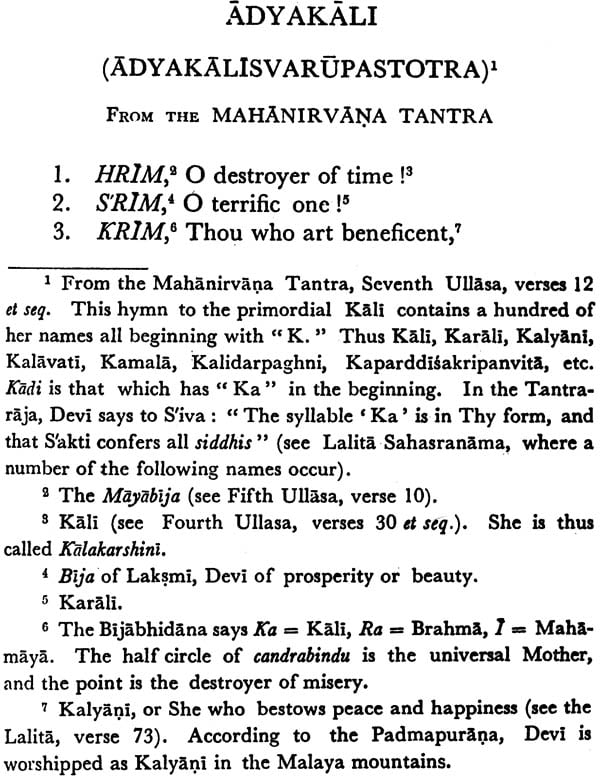
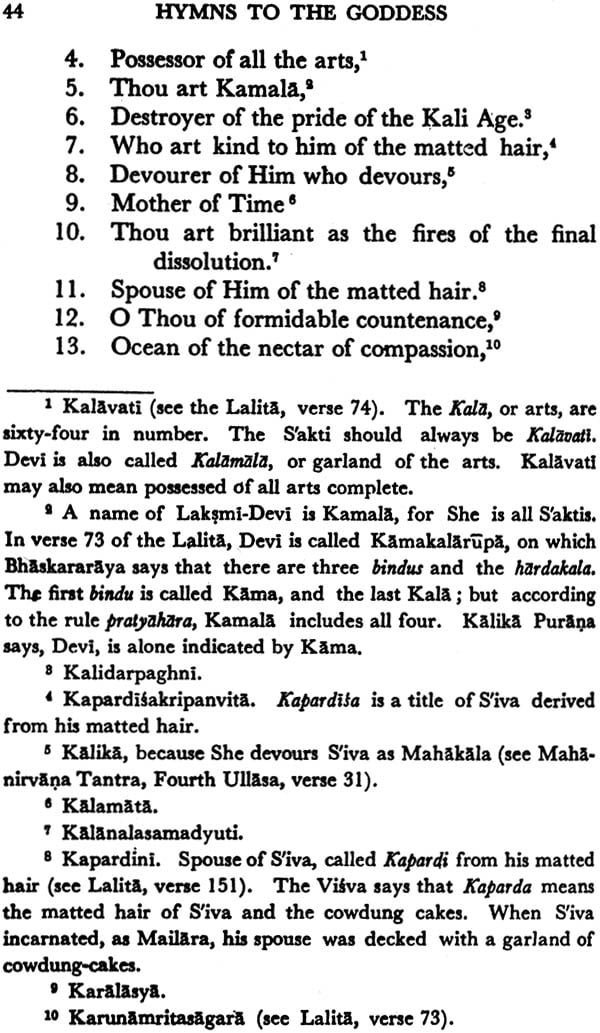

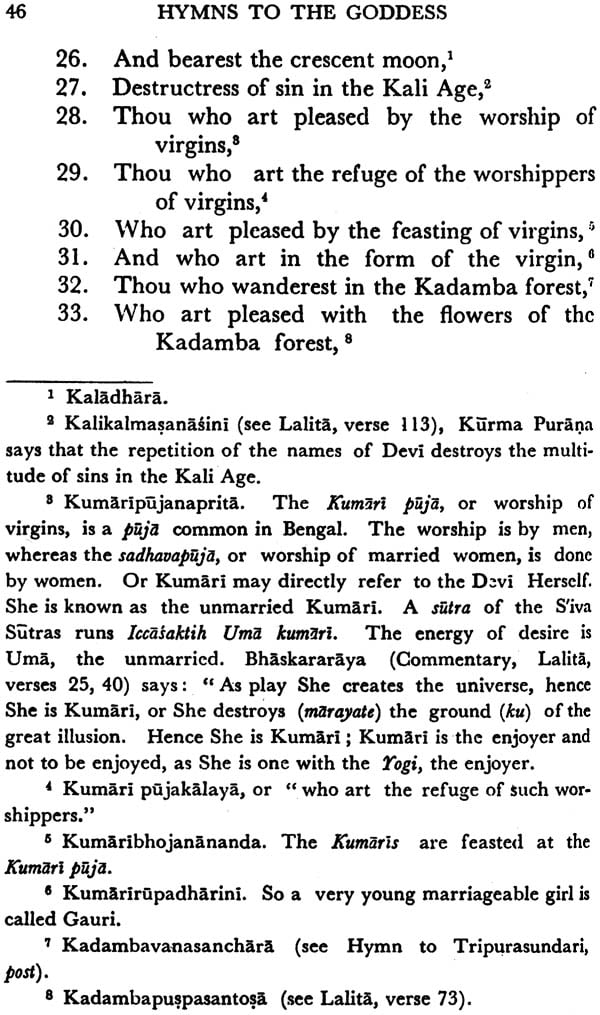
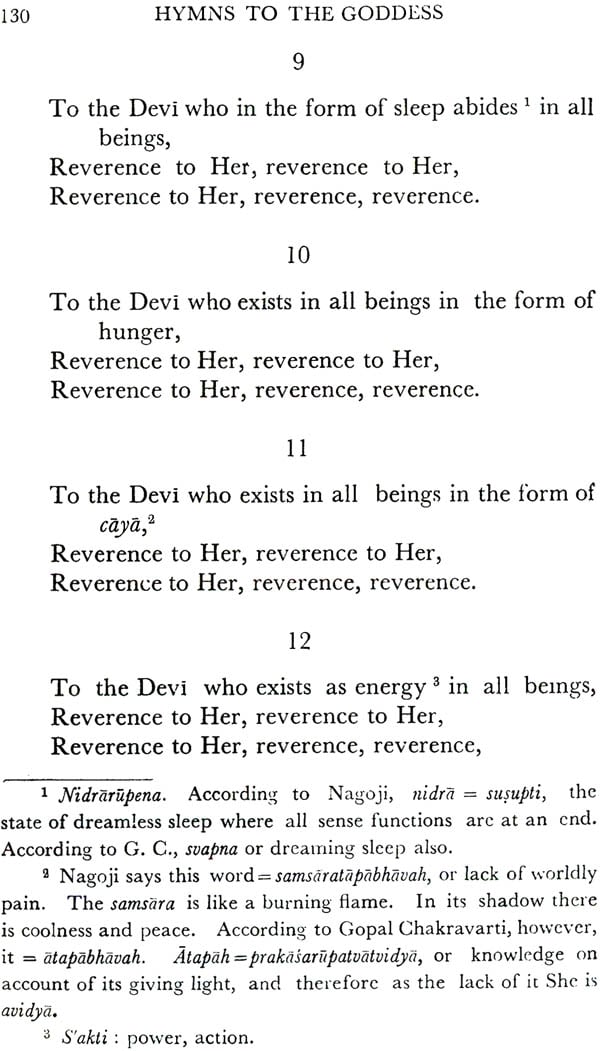

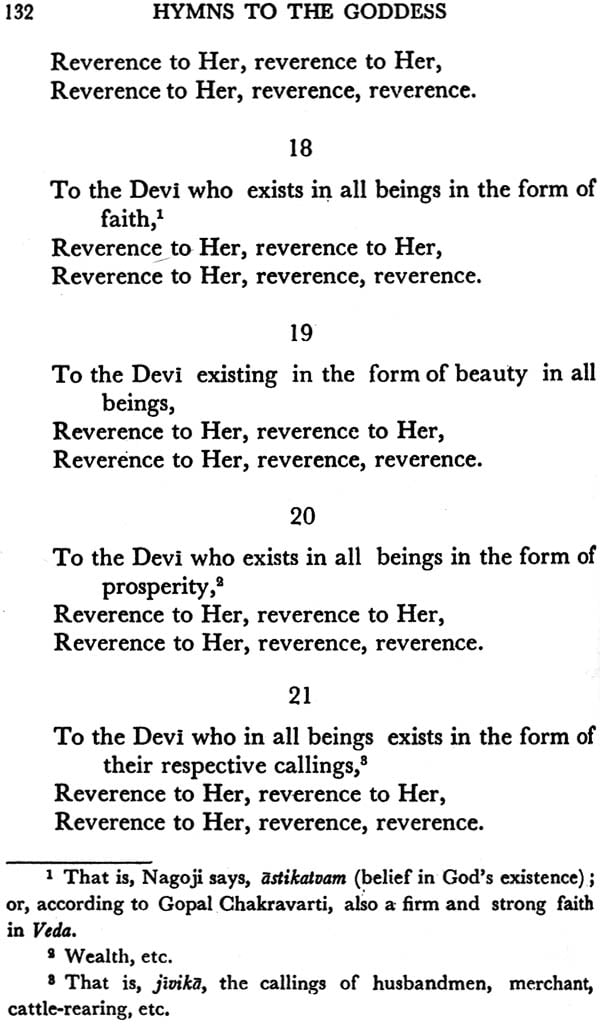
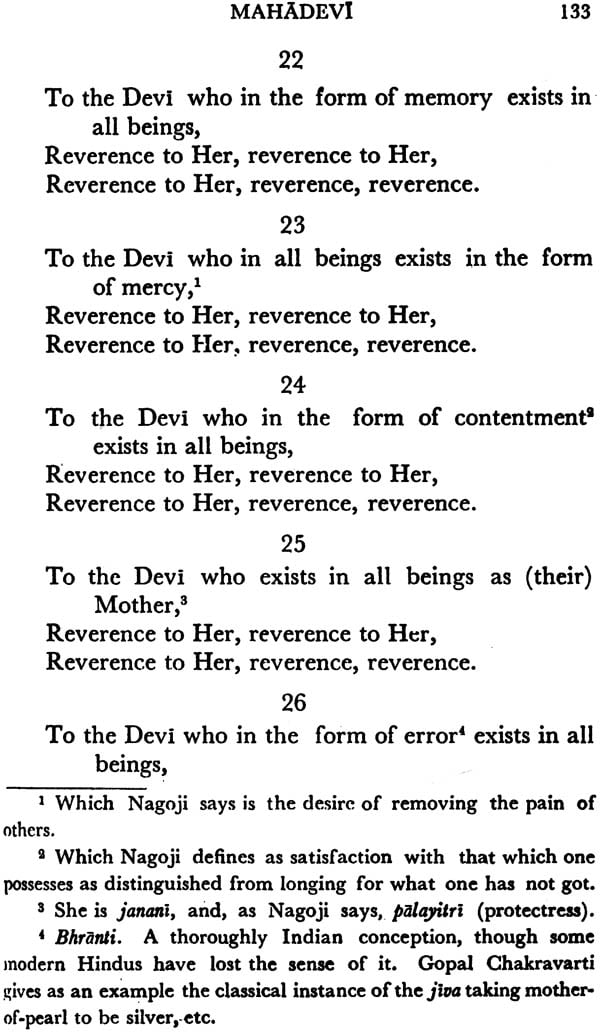

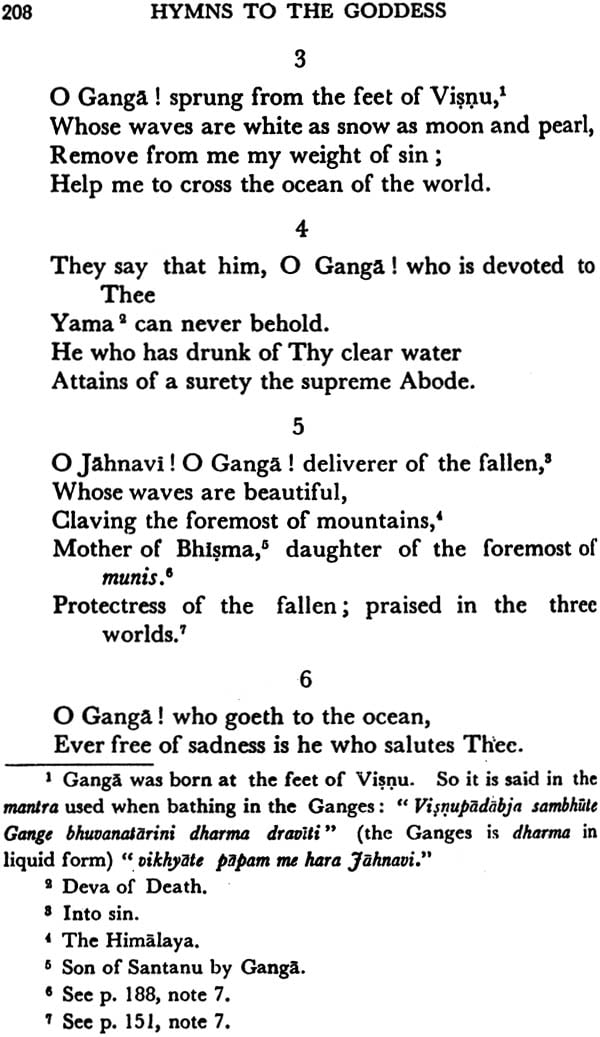
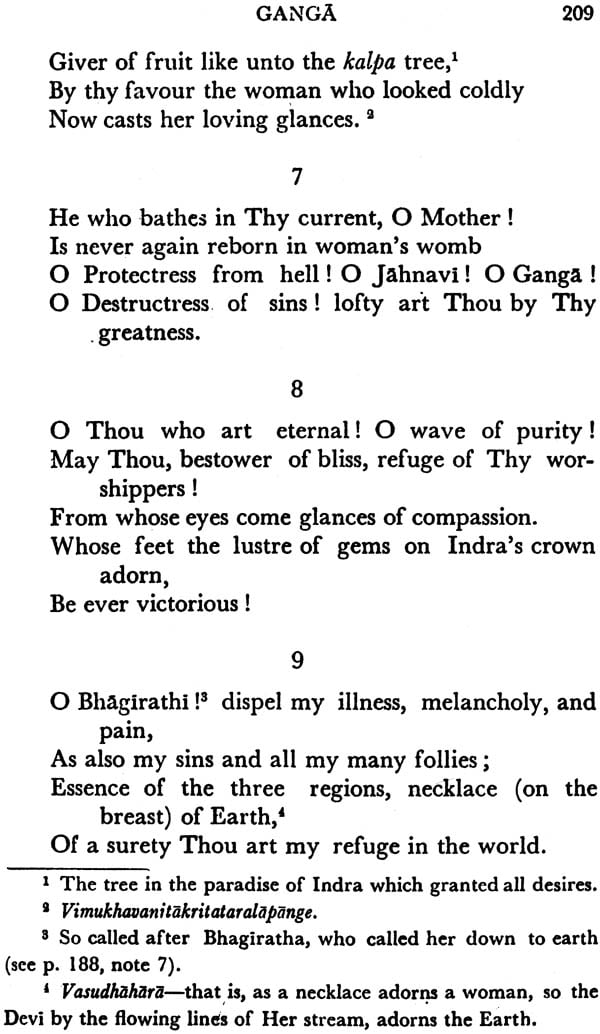

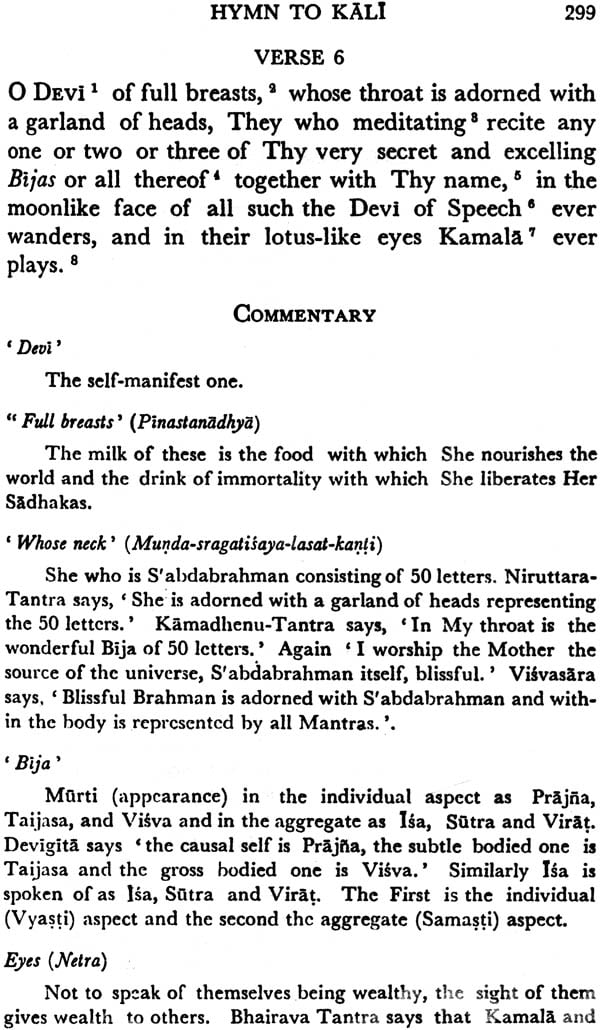
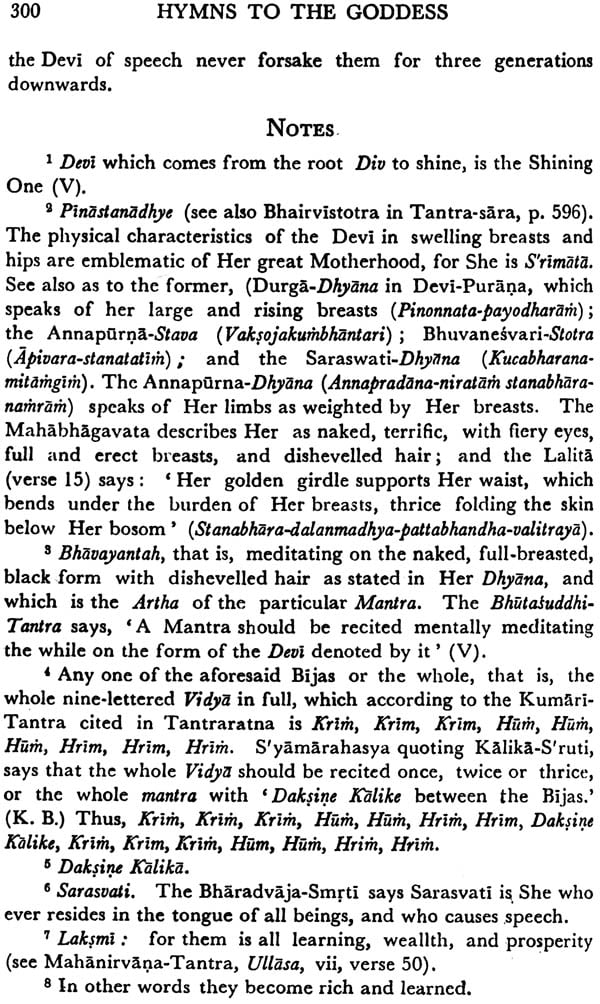
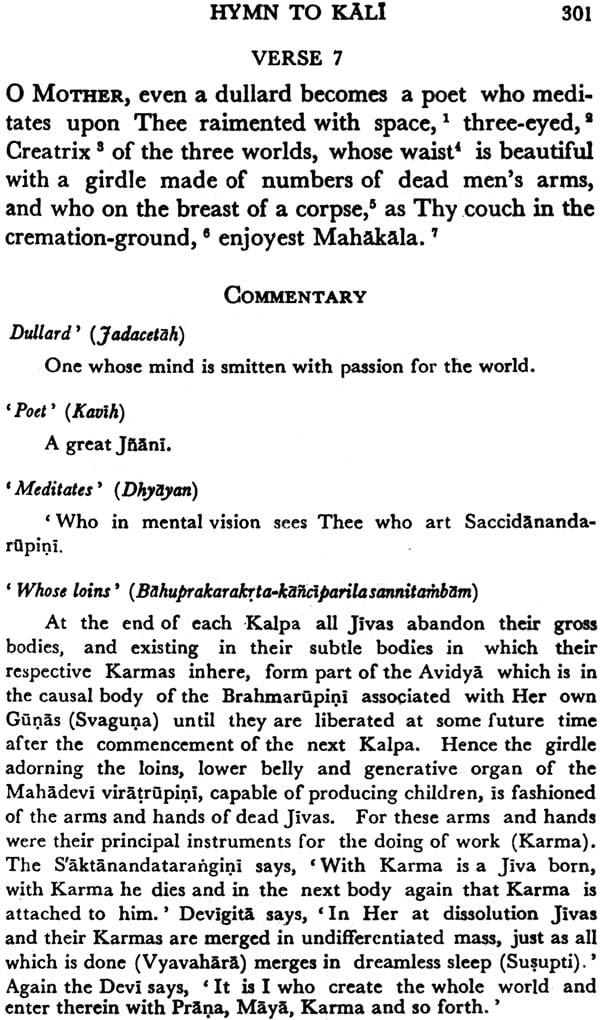
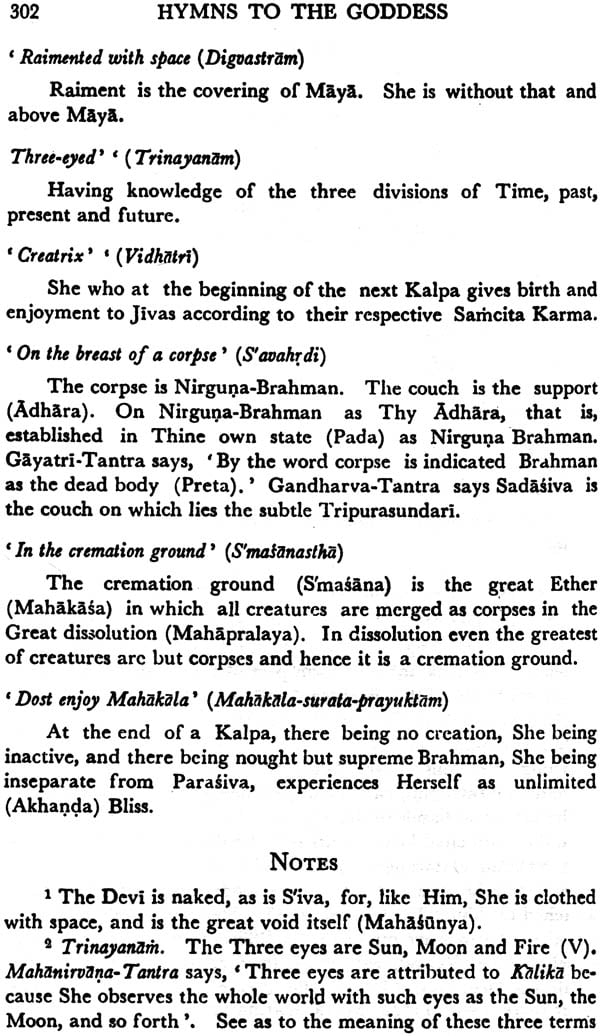
Delivery and Shipping Policy
- INTERNATIONAL SHIPPING
- Rs.1000-1100/kg
- ESTD. Delivery Time: 2-3 weeks (depending on location)
- Bubble Wrapped with Extra Padding
- NATIONAL SHIPPING
- NCR: Rs. 30/half kg
- Standard: Rs. 80/half kg
- Express shipments also available on Request
- ESTD. Delivery Time: Ranging from 1-4 days up to 7 business days (Depending on your choice of Delivery)
- TRACKING
- All orders; national or international, will be provided with a Tracking ID to check the status of their respective orders
- Depending on the Shipping Service, Tracking ID may be used on their respective tracking portals
Frequently Asked Questions (FAQs)
Domestic Shipping: 3-4 Days (after shipping)
International Shipping: 1-2 weeks (based on your location)
You will receive an email once your order has been shipped or you can email us if you didn't receive tracking details (info@mlbd.co.in)
Every book that we sell is the latest edition except all the rare books
Yes, we do provide free shipping, only on domestic orders (within India) above Rs.1500


